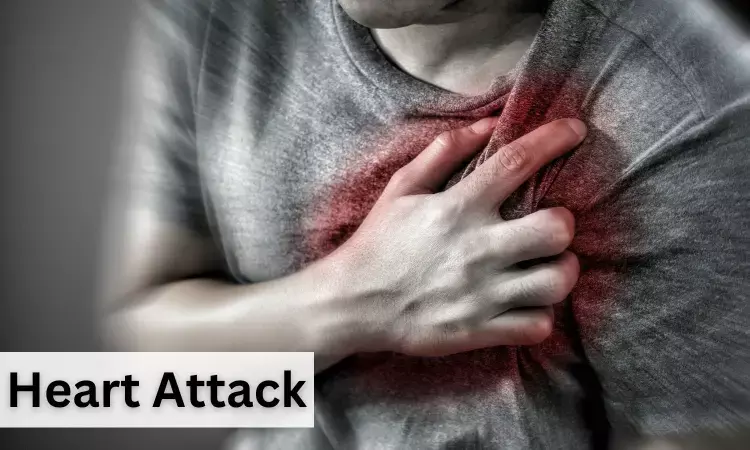- Home
- Medical news & Guidelines
- Anesthesiology
- Cardiology and CTVS
- Critical Care
- Dentistry
- Dermatology
- Diabetes and Endocrinology
- ENT
- Gastroenterology
- Medicine
- Nephrology
- Neurology
- Obstretics-Gynaecology
- Oncology
- Ophthalmology
- Orthopaedics
- Pediatrics-Neonatology
- Psychiatry
- Pulmonology
- Radiology
- Surgery
- Urology
- Laboratory Medicine
- Diet
- Nursing
- Paramedical
- Physiotherapy
- Health news
- Fact Check
- Bone Health Fact Check
- Brain Health Fact Check
- Cancer Related Fact Check
- Child Care Fact Check
- Dental and oral health fact check
- Diabetes and metabolic health fact check
- Diet and Nutrition Fact Check
- Eye and ENT Care Fact Check
- Fitness fact check
- Gut health fact check
- Heart health fact check
- Kidney health fact check
- Medical education fact check
- Men's health fact check
- Respiratory fact check
- Skin and hair care fact check
- Vaccine and Immunization fact check
- Women's health fact check
- AYUSH
- State News
- Andaman and Nicobar Islands
- Andhra Pradesh
- Arunachal Pradesh
- Assam
- Bihar
- Chandigarh
- Chattisgarh
- Dadra and Nagar Haveli
- Daman and Diu
- Delhi
- Goa
- Gujarat
- Haryana
- Himachal Pradesh
- Jammu & Kashmir
- Jharkhand
- Karnataka
- Kerala
- Ladakh
- Lakshadweep
- Madhya Pradesh
- Maharashtra
- Manipur
- Meghalaya
- Mizoram
- Nagaland
- Odisha
- Puducherry
- Punjab
- Rajasthan
- Sikkim
- Tamil Nadu
- Telangana
- Tripura
- Uttar Pradesh
- Uttrakhand
- West Bengal
- Medical Education
- Industry
UTHealth Houston research unveils Link between circadian rhythm and heart attack severity

The molecular mechanism behind why heart attacks can vary in severity depending on the time of day has been uncovered by researchers at UTHealth Houston, potentially paving the way for innovative treatments that align with the natural circadian rhythm.
The study’s findings were published in Nature.
Previous research has shown that the severity of heart damage after an acute myocardial infarction, or heart attack, varies depending on the time of day, with morning attacks resulting in more significant damage and worse outcomes. However, the reasons behind these variations have remained unclear.
“If you have a heart attack in the morning, you are more likely to have fatal arrhythmias, heart failure, and you’re more likely to die from it. The question we asked is ‘Why?’” said Holger Eltzschig, MD, PhD, senior author, and chair and professor of the Department of Anesthesiology, Critical Care and Pain Medicine at McGovern Medical School at UTHealth Houston.
Researchers identified an interaction between two proteins, BMAL1 and HIF2A, as the key factor underlying time-of-day differences in the severity of heart injury following a heart attack. BMAL1 is a core circadian rhythm protein, responsible for regulating biological processes like sleep-wake cycles, metabolism, and hormone release. HIF2A helps the body adapt to hypoxia — low oxygen levels — by stimulating red blood cell production, promoting the growth of new blood vessels, and enhancing cell survival under low-oxygen conditions.
Heart attacks occur when blood flow to the heart is blocked and the muscle begins to die from lack of oxygen. Researchers discovered this interaction between BMAL1 and HIF2A regulated how heart cells in mice responded to low oxygen levels after a heart attack, modulating the heart’s response to injury.
In the preclinical study, researchers found that heart attacks that occurred around 3 a.m. resulted in greater damage to the heart, including larger infarct size and increased risk of heart failure. Heart attacks that occurred at 3 p.m. were less severe, and the heart was better able to adapt to low oxygen levels and promote efficient healing.
The research also revealed that the proteins BMAL1 and HIF2A target a specific gene, amphiregulin (AREG), which plays a vital role in regulating the extent of heart damage throughout the day. By targeting the BMAL1 and HIF2A-AREG pathway with drugs, researchers found they could provide significant protection to the heart, especially when treatments were timed to align with the body’s circadian phase.
According to Eltzschig, future clinical trials must evaluate whether aligning treatments with the body’s internal clock can enhance patient outcomes.
“This discovery opens up new avenues for treating heart attacks by considering the timing of drug administration,” said Eltzschig, who is John P. and Kathrine G. McGovern Distinguished University Chair at McGovern Medical School. “Our findings highlight the potential to use targeted drugs toward those proteins to reduce the severity of heart attacks when administered at specific times. Similarly, patients undergoing cardiac surgery may benefit from such drugs, like the hypoxia-inducible factor activator vadadustat, when given before their operation.”
The research team included Kuang-Lei Tsai, PhD, assistant professor, and Tao Li, PhD, a postdoctoral researcher and co-first author, from the Department of Biochemistry and Molecular Biology at McGovern Medical School. Using high-resolution cryo-electron microscopy, they were able to reveal the detailed structural interactions between BMAL1 and HIF2A to support future drug development targeting the BMAL1-HIF2A complex. This work provided the first direct molecular evidence of their complex formation and offered critical insights that could guide the development of new therapeutic strategies, Eltzschig said.
Reference:
Ruan, W., Li, T., Bang, I.H. et al. BMAL1–HIF2A heterodimer modulates circadian variations of myocardial injury. Nature (2025). https://doi.org/10.1038/s41586-025-08898-z
Dr Prem Aggarwal, (MD Medicine, DNB Medicine, DNB Cardiology) is a Cardiologist by profession and also the Co-founder and Chairman of Medical Dialogues. He focuses on news and perspectives about cardiology, and medicine related developments at Medical Dialogues. He can be reached out at drprem@medicaldialogues.in


